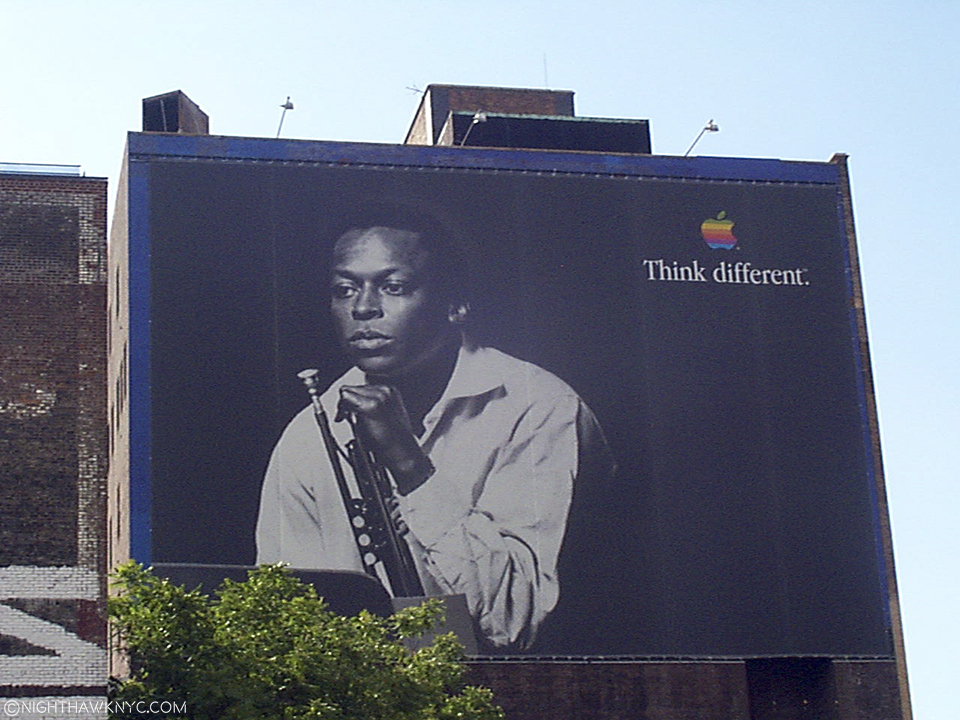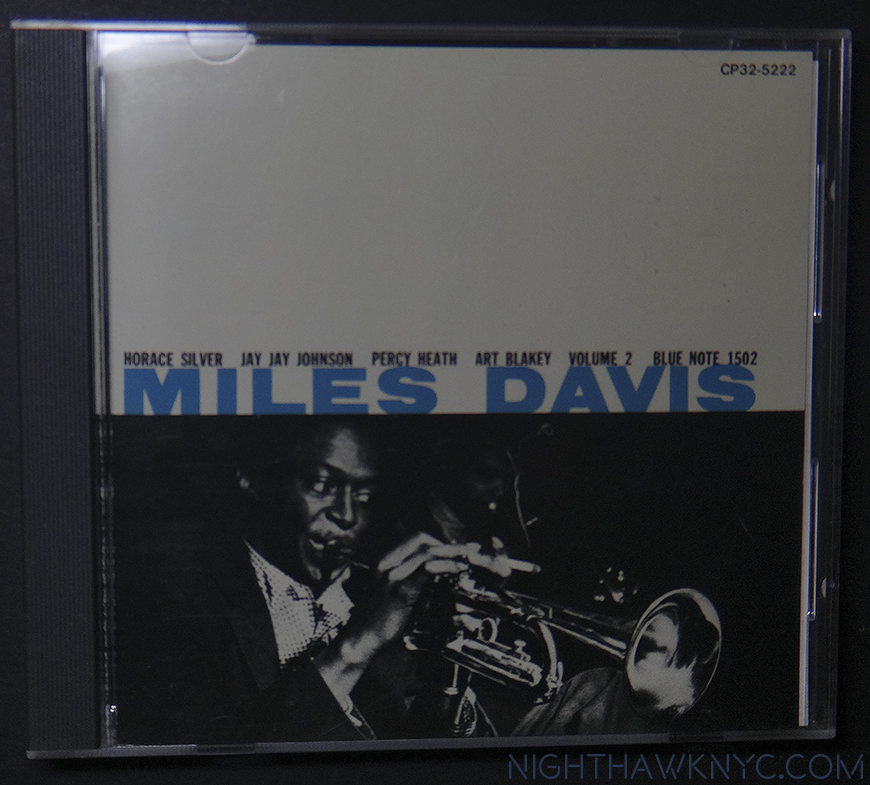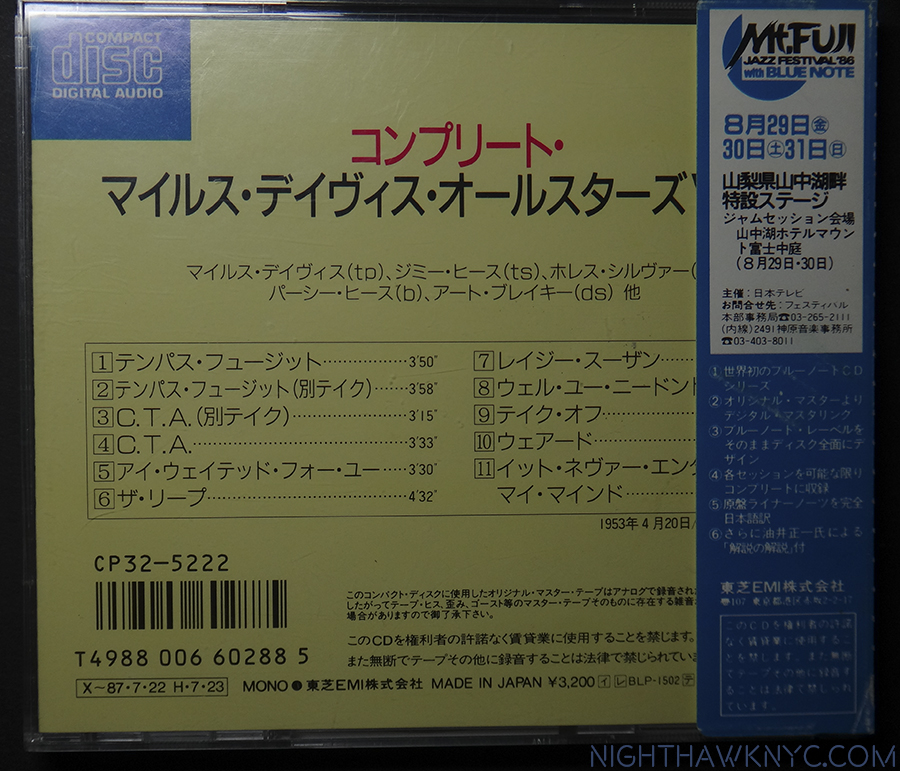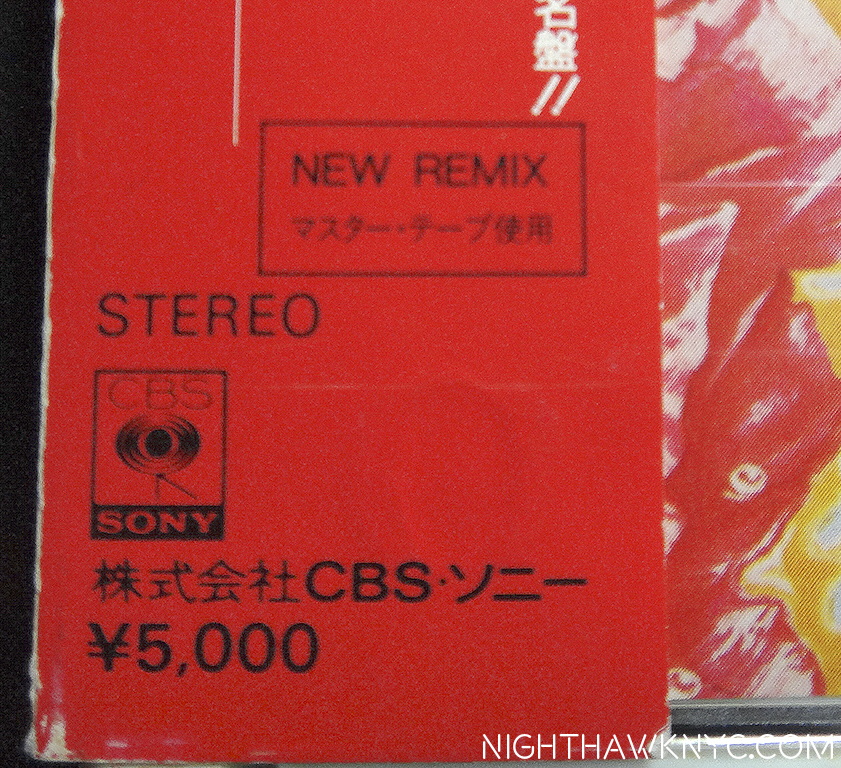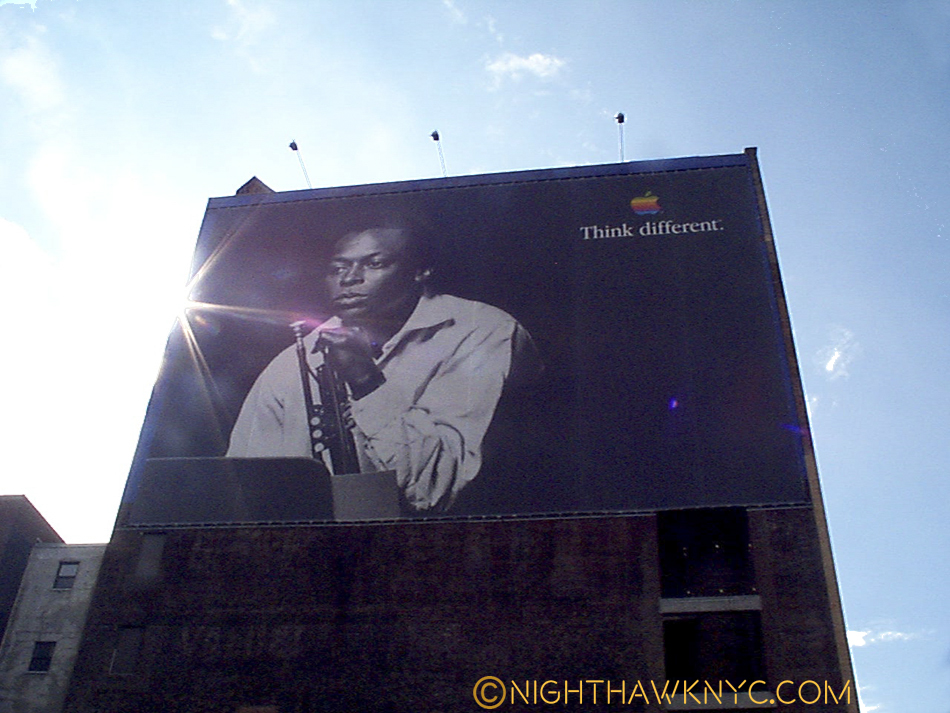This site is Free & Ad-Free! If you find this piece worthwhile, please donate via PayPal to support it & independent Art writing. You can also support it by buying Art & books! Details at the end. Thank you.
Written & Photographed by Kenn Sava.
A ShortList Of Recommended Miles Davis Albums
This is an Addendum to my “Riffing On Miles Davis” Post in response to a note I’ve gotten asking what specific recordings I’d recommend listeners check out to hear Miles, and/or get a fuller appreciation of his accomplishment over the 40 years he recorded albums under his own name1. Personally? Miles Davis was my biggest musical influence, as he was for many of the musicians I worked with or admired. He was a living legend to us, akin to what Picasso was to visual Artists during his lifetime, and yes, there are quite a few interesting similarities between Miles & Picasso, but that’s a different piece. Ok. So, here’s my “ShortList” of essential Miles albums- suggestions for both a listener new to Miles Davis to start with, and for where to go from there. To clarify- Miles’s earliest records are almost 65 years old now. Older albums get re-released, if they continue to be worth hearing!, all the time, often with different names. Almost all of Miles’s are still available. I’m using their original album titles here. Disclaimer- This is a “ShortList”- a place to start. If I’ve left your favorite out? I hear you. I’m leaving out some of mine, too. I think we can all agree that there is A LOT of great music in his Discography. Dip your toe in and see where the River Miles leads you. I hope we can all agree on that.
First, Kind of Blue– Yeah. What else would be first? It seems to be every critic’s #1 choice as the first Jazz album you should have. Ok, I get that. For me, it’s much more. It’s a record I’ve lived with for most of the 56 years since its been released. I’ve gone through phases with it. First, there was the “tunes” phase- listening to, and loving the songs as songs, while marveling that they were basically composed at the recording sessions, or as legend has it, by Miles in a taxi on the way to them.
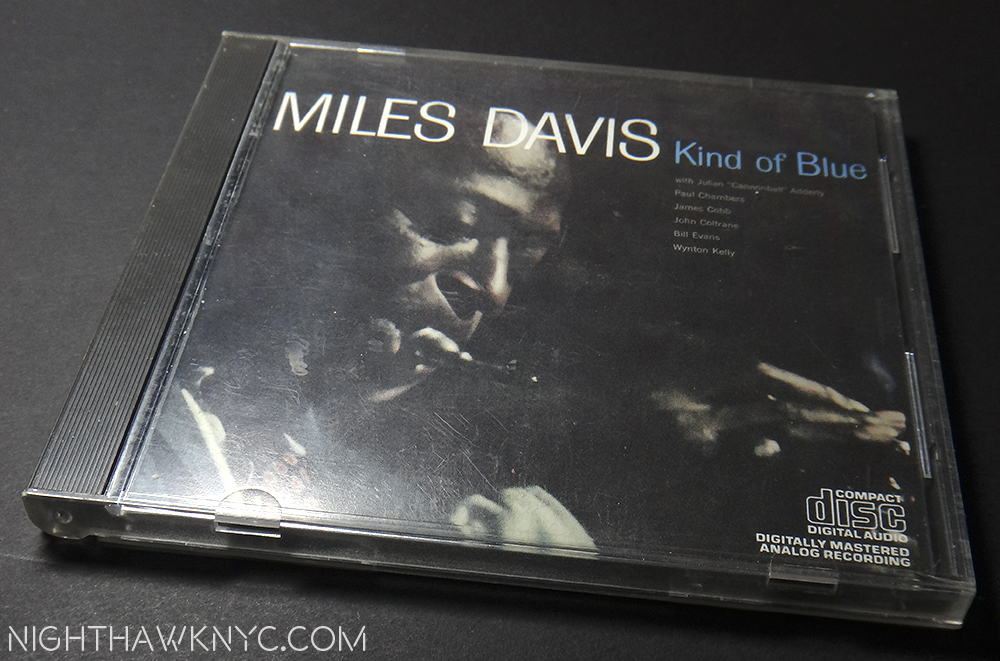
The Official Soundtrack of The Night. I go to The Met to see Art. I listen to this to hear it. I wore out the Lp, then bought this, the first CD release. There’s now a 50th Anniversary 2 Disc edition with outtakes- Get that.
Then, there was the Miles-“So-What”-Solo-Phase, which most musicians probably go through. I’m talking about Miles’ solo on “So What,” the first solo on the record. First, you marvel at its utter perfection. Finally, you write it out, study it, and learn to play it on whatever instrument you play. Then? You realize that was easy enough, but it doesn’t come within miles (sorry) of what he did. You start to wonder why not, and you then start to become a “Musician.” Further, jazz can be taught, but Jazz can’t be taught, I believe. The intellect, the sensibility, the taste, the creativity, the feeling, and the unique essence that makes a Master Musician are either there, or they’re not. Even if they are all there? You’re still not Miles. Only Miles was Miles. If you want to know why he was so great, or hear music that is Art, in my opinion, listen to this.
In the 1990’s I was fortunate enough to know, and once work with, the multi-intrumentalist & vocalist Mark Ledford. He passed way far too soon and is probably best known for having been in Pat Metheny’s Band, and having a solo CD out on Verve called Miles 2 Go. He also played with the late, great Joe Zawinul, the co-founder of the legendary band, Weather Report. Joe composed “In A Silent Way,” now a Miles Davis classic, and performed on some of Miles’ classic albums. Mark introduced me to Mr. Zawinul, one evening at the Blue Note, NYC. I was a very long time lover of Joe Zawinul’s music going back before his days with Weather Report, to those days he spent with Miles. Yet, when I finally got to meet him, all I could ask him was, “Have you heard Led play trumpet?” I wondered if he felt about Mark’s playing the way I did. Mark Ledford uncannily sounded like Miles on trumpet. Believe me, I don’t say that lightly. The highway of Jazz is littered with “Miles-wannabees,” who never were. Like me, Mark Ledford had grown up with Miles, and unlike me, he played trumpet. I guess I shouldn’t have been surprised, but when I first heard him play, I was like “WOW. This is uncanny.” I was lucky enough to have him play trumpet on one of my records.
Anyway, the point is that even Mark Ledford, a brilliant multi-talented musician, who could sound more like Miles than any of the millions of Miles imitators, wasn’t Miles. He would tell you that. Listening to Miles and trying to think where he was going…what would come next…was a game I still play. Then? There was that sound. As I wrote earlier, for me, his sound defines living in NYC as much as any sound I can think of. People in London, Cairo, Tokyo and Moscow probably feel the same way. Well? Sorry, but Kind of Blue was recorded here, within walking distance from where I’m writing this, so we’ll take dibs on it. Yet, Kind of Blue is as much about Miles’ sound when he plays, as it is about the sound when he didn’t play. It’s a masterpiece of silence, as much as it is of music, of “negative space,” as Artists call it, as I mentioned in my first Miles Post. When you go back and listen to earlier Miles albums you can hear it there, too. But, it’s a featured player here, and something that became integral to listening to Miles henceforth. For me, this silence is what puts Miles’ legendary coolness over the top. No other musician, in any kind of music has ever been as revered for what he played as for what he chose not to play.
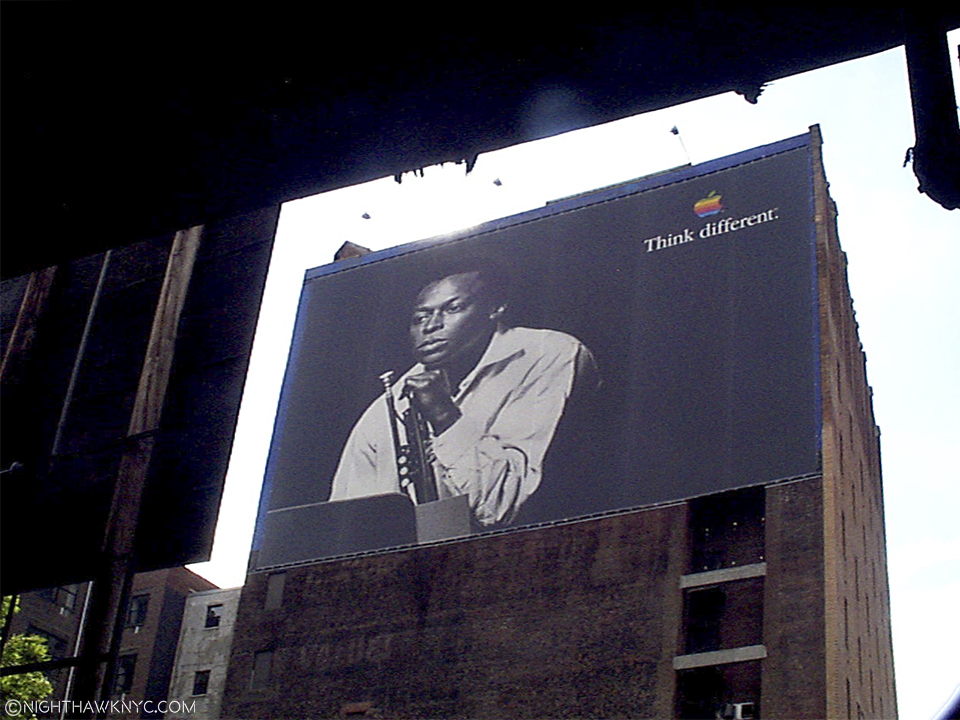
Another view of the “Think Different” Billboard, June, 1998. This one shot from under what is now the High Line
Time would go by, and I’d come back to Kind of Blue, again. This time for Trane. John Coltrane is a world unto himself. He was as revolutionary a figure as Miles was, in his own way. One of the first “mainstream” jazz musicians to experiment and adopt elements of the avant garde in his work, he was a man who was on a mission. A mission that ended far too soon, when he suddenly passed in 1967, age 40! Look at his discography and you’d think he lived to be 100, almost no one was as prolific a recording Artist as John Coltrane (Thank goodness!) Like Miles, all periods of Trane’s work are important, and his period with Miles, which would end shortly, was certainly up there with any of them. While Miles was creating perfect statements with the utmost economy, John Coltrane was wailing. He often sounds like a man who knows he doesn’t have a lot of time to get it all in. Possessing one of the most formidable techniques in the long & storied history of the Tenor Sax in Jazz, he used every ounce of it, seemingly, all the time. Miles once said, no doubt referring to him, “I had seven tenor players, once.” Yet, in spite of what some critics say, I don’t ever hear him overplaying. Later, his explorations carried him much further afield than we hear him here, and that’s a different story, but on Kind of Blue, he is the perfect counterfoil for Miles (as he is one virtually all of his recordings with him.)
So, you can listen to “Kind of Blue” for the music. You can listen to it for Miles. You can listen to it for Trane.
And, you can also listen to it for the great Cannonball Adderley. Or the great Bill Evans, or for the band as a whole (Paul Chambers bass and Jimmy Cobb’s drums complete the band, with Wynton Kelly on piano on one track), a unique combination of master musicians, all at their peak, all together in one room. Thank Buddha there was recording equipment, engineers present, and someone remembered to hit the “Record” button! (I’ve been to sessions where someone actually forgot to.)
After Kind of Blue, there are many different ways you can go in exploring Miles’ recorded legacy. For me, I’d go with the music of the group that took acoustic music further than anyone has- before or since- Miles’ Quintet of 1965-67, the so-called “Second Great Quintet.”.
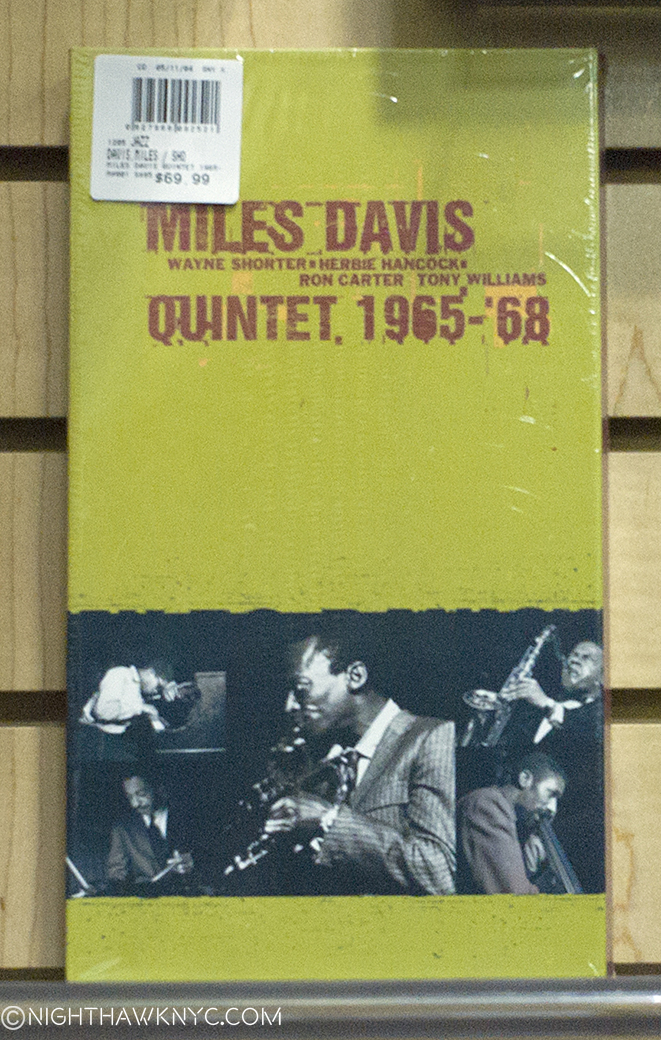
You’re looking at nothing less than what remains the State of The Art in small group Jazz. Available as individual records, or in this Complete Box Set, seen at Barnes & Noble, Union Square, one of the few CD Stores left in NYC this week. I never leave home without it…on my Phone.
To clarify- Miles’ “First Great Quintet” was the working group (i.e. they performed live) he had from 1955-58 that included Tenor Saxophonist John Coltrane. The group that recorded Kind of Blue is referred to as his “Sextet.” For me, everything the Second Great Quintet recorded is essential. Miles was joined by Wayne Shorter (Tenor, and later, Soprano Sax), Herbie Hancock (Piano), Ron Carter (Bass) and Tony Williams (Drums)- a group of young, and already accomplished, talents who grew to become masters on their instruments during this experience. One of their albums was titled “E.S.P.,” which perfectly summed up the previously unheard level of group intercommunication they attained as well as anything could. Therefore, the “album” I’m recommending is The Complete Columbia Studio Recordings Of The Miles Davis Quintet January 1965 To June 1968, a 6 CD set, pictured above. It’s a compilation of their albums of the period. It would be very very hard for me to pick one album. If you held a gun to my head? E.S.P., then Nefertiti, The Sorceror, Miles Smiles, but we are splitting hairs now.
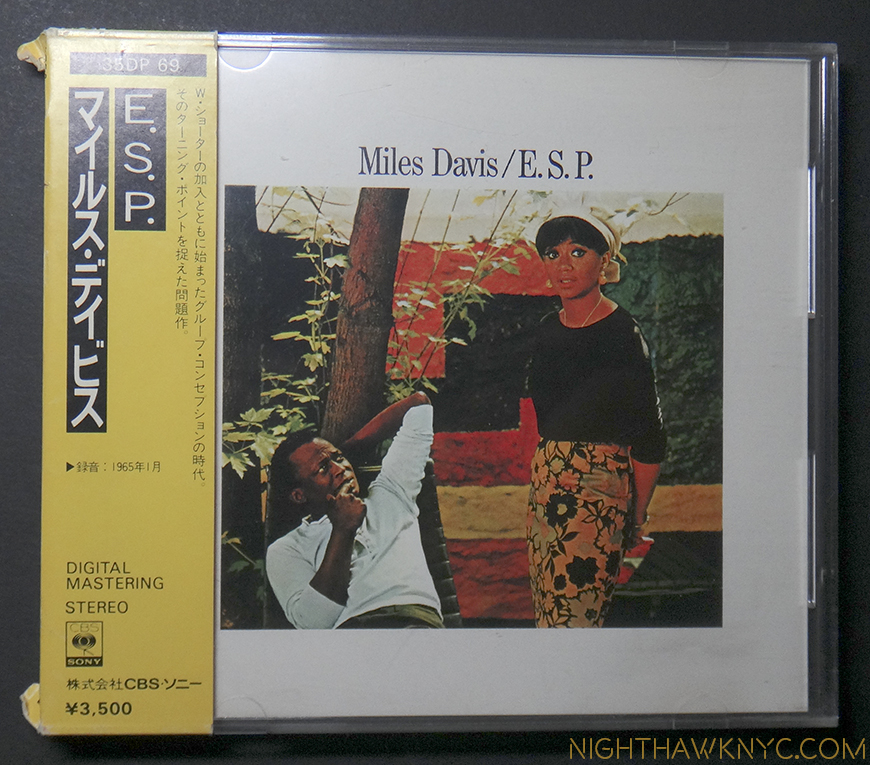
E.S.P. as a single Lp/CD. While the music inside is telepathic, the cover, with then wife Cicely Tyson, makes me wonder, too. See note below about Japanese pressings.
This is music that features Miles at the peak of his powers, in the company of 4 young musicians (Tony Williams was 17 when he joined Miles!) who are becoming Masters, themselves, right in front of our ears. A key point in this evolution occurred when when the band was performing live early on. Miles wondered why the group played differently, more adventurously, behind Wayne’s solos than it did behind his. So he called them out on it and told them to play the same way behind his. In short order the group was matching its leader at every turn, and, by the time of their later recordings, even push him. It’s exciting, fresh, exploratory and endlessly vital music, that, in my opinion, redefined what acoustic jazz could be. Those terms are carried on in the superb Wayne Shorter Quartet of 2001 to date, one of the few bands that carries on in the spirit of the GQ2, perhaps at the behest of Miles, himself, who reputedly passed the torch to Wayne the last time they spoke. I digress.
If, like me, you get to the point where you must hear every note the GQ2 played, than by all means check out The Complete Live At The Plugged Nickel, Miles In Berlin, and the Live In Europe 1967: The Bootleg Series Vol. 1, (a 2011 release that only scratches the surface of rare live recordings by this band that are avidly traded among collectors. These are not on the “Shortlist,” however. Many of these are in surprisingly good recording quality, having originated from Radio or TV Broadcasts- or both.)
Many Miles fans will part ways with me here, when I make my next selections, and that’s fine. It’s my personal opinion. I think we’d all agree that it’s best to hear as much of Miles’ music as one can and decide for yourself, what speaks to you. There are about 50 studio albums to choose from that Miles recorded, 36 or so live albums, but, as I said, these are augmented by hundreds of live tapes that collectors trade. This list is merely a suggested starting point to help you figure out where you’d like to go, or suggest new roads if you’ve dipped your toe in Miles’ Ocean.
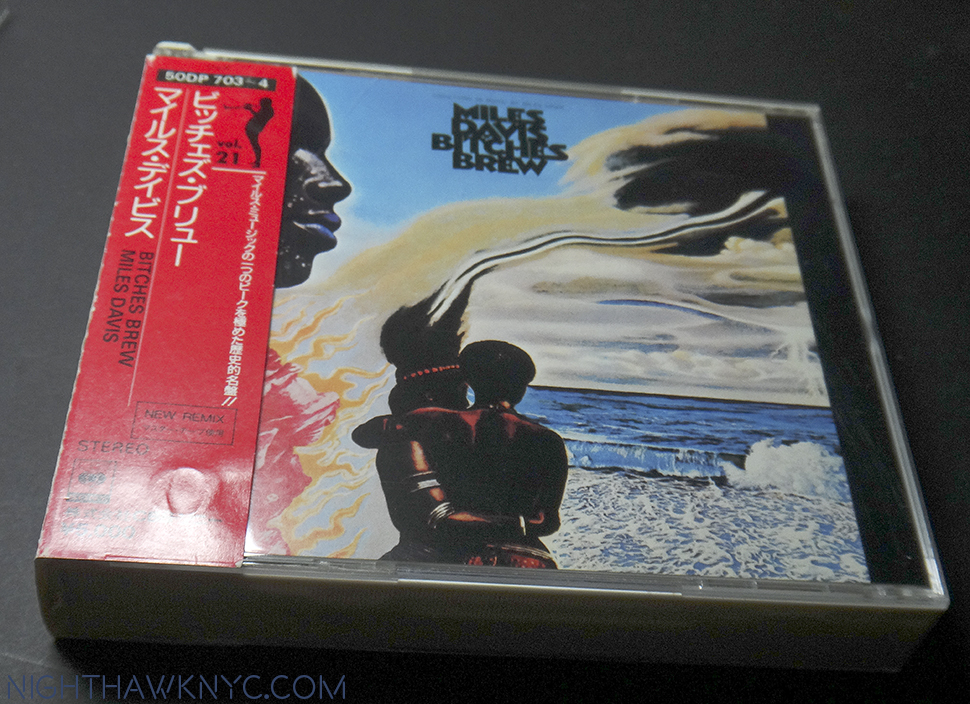
This one changed my life. Oh, and music has never been the same since, too. Perfectly titled. Perfect cover art. Perfectly Revolutionary.
I’d suggest Bitches Brew next. As I touched on previously, Miles Running The Voodoo Down. it was a revolution in a career of many innovations. It still sounds ahead of its time to me. It has that air of improvisation that Kind of Blue has, but in an entirely different way. Wayne, Keyboardists Joe Zawinul, Chick Corea, Larry Young, Guitarist John McLaughlin, Bass Clairnetist(!) Bennie Maupin, Bassist Dave Holland, and Drummers Lenny White, Jack DeJohnette, Billy Cobham and Percussionists Airto and Don Alias, joined Miles in brewing up a concoction that melted the borders not only between rock and jazz but between so many other kinds of music at the same time, it was like the flat earth had suddenly become round. I don’t think it’s an overstatement to say it had the equivalent effect of The Beatles going psychedelic 2 years earlier with the release of “Strawberry Fields Forever.” The influence of this album is everywhere I turn today- every time I see a jazz group that includes an electric instrument, there it is, or a group of some other kind of music that has jazz elements (including Prince) and an electric instrument or two.
Miles’ work with Gil Evans is also revolutionary, and much less controversial. Many consider it his most beautiful music. It extends as far back as 1949-50 and is collected on the legendary, and highly recommended, album The Complete Birth of The Cool, which is exactly what it was. Miles has been “cool” ever since. For me? He defines it. The shot below is from a radio session done the year before the record. Miles was playing Gil Evans Arrangements that featured unusual instruments for small group jazz, like the tuba and french horn. So, the band became known as “Miles’ Tuba Band.” About 10 years later, they reconvened to created the masterpieces “Sketches of Spain” and “Porgy and Bess,” (yes, the Gershwin Opera). Add them to your list.
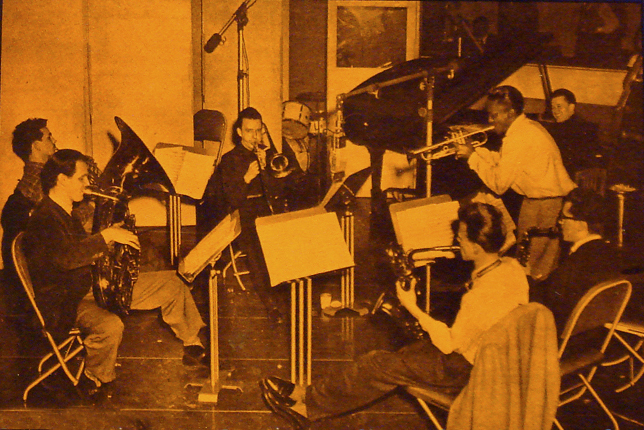
Pre-Birth of the Cool. Miles, NYC in 1948 with Lee Konitz on Alto, and Gerry Mulligan on Baritone Saxes, Left, John Barber on Tuba. From my collection.
Ok, it’s been hard to leave off other albums featuring John Coltrane, so I will wait no longer.
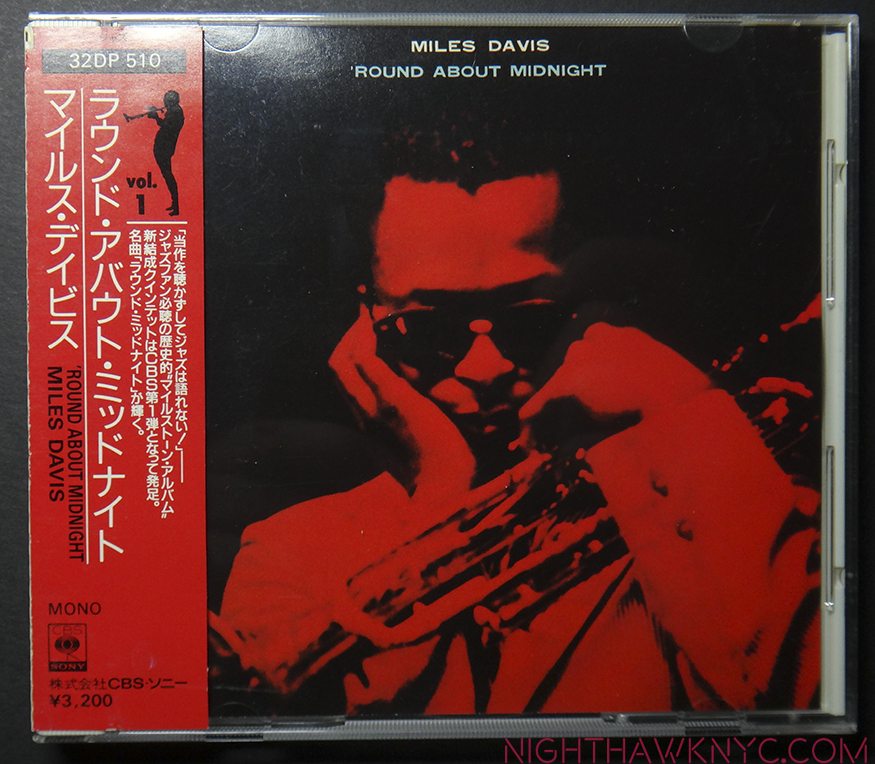
No. He’s not posing here, or in the silhouette. Only Sinatra and Ella can “sing” standards with Miles. (Louis and Billie ain’t bad, either.)
Milestones is a classic. Along with Trane, it contains another (like on Kind of Blue) rare appearance by Cannonball Adderley, along with Red Garland (Piano), Paul Chambers (Bass), and Philly Joe Jones (Drums). This band, without Cannonball, comprised Miles “First Great Quintet.” “‘Round About Midnight,” and “Miles Ahead” would be your next stops for the studio work of this group. Two points should be made here- 1) Miles created these records for Columbia Records, who he signed with in 1955. Before that, this group recorded for Prestige. Among the Prestige titles, I love Workin’ and Steamin’, though Cookin’ and Relaxin are right up there as well.
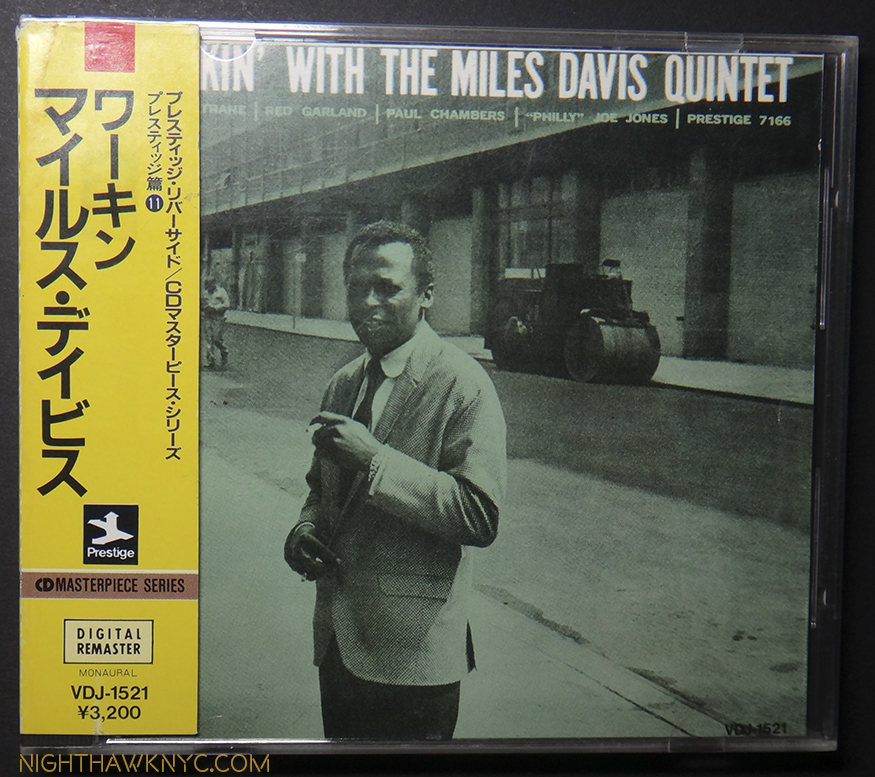
Workin’” but not Steamin’ “It Never Entered My Mind” is on this. One of his greatest performances for my money.
After these, head to the even earlier Blue Note recordings Miles made, that were released as Young Man With A Horn, and then Miles Davis Volume 2 and Volume 3, from 1952-54. They have been collected in a Blue Note “Complete” CD set.
Oh. The other point, 2) is that the Miles in that as great as their studio records are, and they are among the greatest ever made by anyone, Miles and Coltrane MUST be heard together live, in my opinion, to get any kind of full appreciation of their chemistry together. As I’ve said, they were the perfect foils- Miles the genius of understatement, the inventor (to my way of thinking) of musical silence, contrasted by John Coltrane, who was at that time working on development of the final stages of what would be called his “sheets of sound” style. What might sound on paper like a musical train wreck (no pun intended), was in reality magic. Art. From there, there are, once again, bootleg recordings around, many of which belie the late 1950’s dates, with more than acceptable sound. The greatest “official” live album is Jazz At The Plaza, a somewhat unintended album (the musicians didn’t know they were being recorded), but a miraculous live document of the Miles Davis Kind Of Blue Sextet.
Ok. Still with me? Want to hear more? Good! We still many Miles to go! (Sorry.)
Before, and after, Bitches Brew was a very fertile period for Miles. In A Silent Way, and Jack Johnson are bookends in a sense- the former beautiful, subtle, crystalline, thanks in no small part to the presence of Joe Zawinul, who wrote the title track, in a band that includes 4/5 of the Second Great Quintet, along with John McLaughlin (Guitar), Dave Holland (Bass) and Chick Corea joining Hancock and Zawinul on Keyboards). Recorded in 1969, it’s the album right before Brew. “Jack Johnson” was recorded immediately after Brew in February and April, 1970. Miles Backed by “the greatest rock and roll band you have ever heard” (QUOTE) (McLaughlin, Sonny Sharrock- Guitars, Hancock & Corea- Keyboards, Benny Maupin on Bass Clarinet and Jack DeJohnette and Billy Cobham on Drums, he wasn’t lying.
You’ll notice that many of the albums pictured are the Japanese CD’s. Why? The choice of Lp or CD is up to you. I actually have both of many of these, but my CD’s were nearer to hand.) In records and CD’s there are some who think the Japanese pressings sound better than the American versions. For Miles’ albums, this was true years ago, both in the later days of vinyl Lp’s and the early days of CD’s when many were rushed into production here in the US while paying little attention to sonic quality, sometimes, not even bothering to find the correct master tapes. So, early on, I went for the Japanese CBS/Sony pressings, which are what I still have and are shown here. CBS/Sony (Japanese Columbia Records) was legendarily fastidious in their attention to sound quality.
A bigger potential issue is that Columbia, which owns most of Miles recordings up to the 1980’s undertook a reissue program that saw them scour their vaults for unreleased takes to include as part of a series of “Complete” Box Sets. You should also be aware that they remixed (and remastered) the original tapes. This is something I find potentially troublesome in some cases. There is a lot to be said for having the original mixes, when an album was orignally mixed (i.e. was recorded on multi-track equipment.) Off the top of my head, I’m not sure what the current state is of mixes one would get if buying these albums on CD’s today. They might be the original mixes, which would have been done by Miles’ legendary Columbia producer, Teo Macero, more likely, they may have been remixed. It should say somewhere on the packaging. I don’t have them, so I can’t check. The Japanese CBS/Sony pressings I show are both. Bitches Brew states that it is a “New Remix,” but there is no additional information anywhere in the package.
I’d have to compare them side by side with the original Lp versions out now to know if they’re different. Does it make a difference? Possibly not. Miles music was acoustic up to 1969-1970 and performed in small groups. There’s really not a lot to mess up there, though anything is possible. (Note- Sony, who bought Columbia, issued a 9 CD Box set called Miles Davis: The Original Mono Recordings in 2013, of his Columbia albums through 1961, with a few extras. I haven’t heard this because I prefer Stereo, when it issued that way, along with mono.) With the later albums, there’s much more potential for difference. I’m saying all of this to make the buyer aware of it, though it’s a subject I have not as yet seen anyone mention. It applies to other artists, especially rock artists, much more than it might to jazz artists for the reasons I mention. Still, with any classic recordings, it is something to keep an eye, and ear on. IF you really want to get to the heart of the matter? Go for the original Lp’s. Yes, you can spent a fortune on original pressings, but if you are only looking to get the original mixes, any of the issues from the Lp era will contain them (I can’t vouch for the currently available Lp reissues.) The front cover images of these Japanese CBS/Sony CD’s are the same as the original Lp’s.
Ok. back to the matter at hand. While Miles’ recording career lasted about 40 years, he took about 6 years off from about 1974 to 1980. In 1981 he suddenly returned, with a new album, and a live tour. He continued to do both until he passed in September, 1991. We miss him, still.
The return from retirement.
In 1980 Miles came back after over a decade off. He recorded a string of quite popular albums, but only two of them are going to make my “Shortlist.”
Tutu is a different type of masterpiece. Produced by the very underrated Marcus Miller, for me, it harkens back to Gil Evans while using every bit of a contemporary sound, with utmost taste. Brilliant and unexpected, it’s matched every bit by the incredible photography on the cover and in the booklet.
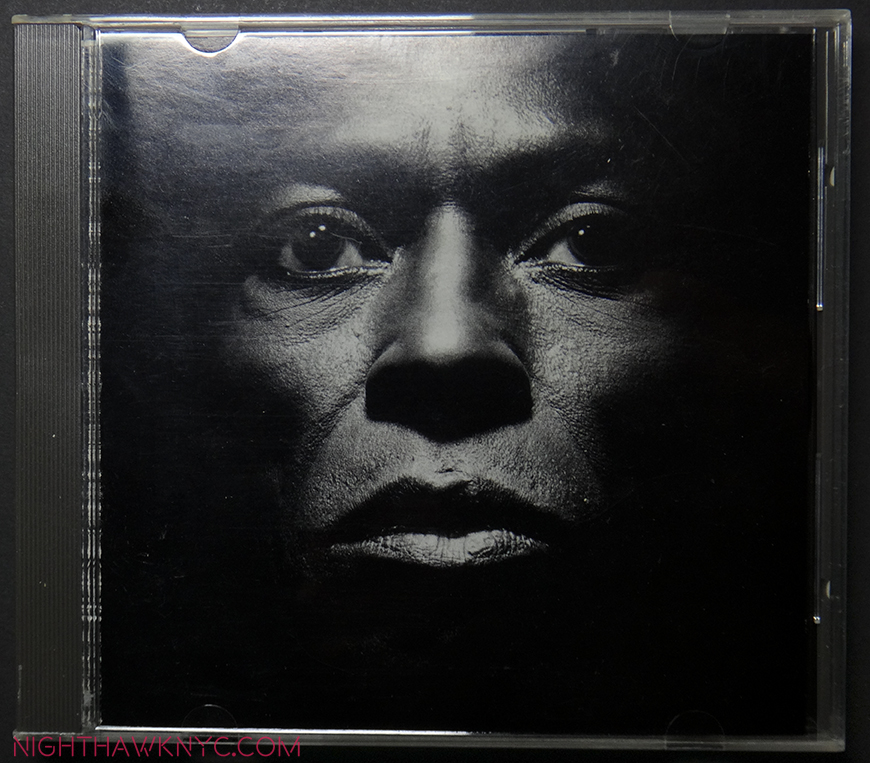
The “Prince of Darkness” looms out of the Darkness on the cover of. Tutu, by Irving Penn, part of what I think is the greatest photoshoot of Miles ever. The 4 foot poster of this was pictured in my prior Post.
And finally, Miles & Quincy: Live At Montreux. Recorded two and a half months before Miles’ passing, it was one of only two times Miles looked back musically, and WHAT a time! With an orchestra led by Quincy Jones, Miles actually plays the music he made famous with Gil Evans on “Porgy & Bess” and “Sketches of Spain,” 30 years earlier. Most of his fans thought he would NEVER play them again. It was the last musically revolutionary thing he did. Then, two days later in Paris, France, he, again, walked down memory lane, but this time in the company of many of the now Masters who were once his sidemen, including- Wayne Shorter, Joe Zawinul, Herbie Hancock, Chick Corea, Jackie McLean, John Scofield and Dave Holland, among others. Thankfully, Audio and Video recordings of both concerts exist.
A perfect conclusion to one of the most important careers in the history of recorded music.
Oh! Lest I forget to at least mention that Miles also recorded extensively with no less than Charlie “Bird” Parker, who he was obsessed to find after moving to NYC to study at Julliard, at age 18. He not only found him, Bird moved in with him, and the two played together off and on regularly during Davis’ key formative years. Many of these recordings are still available, and while they are quite good, and endlessly fascinating, I’d recommend them to fans who have become obsessed with Miles as “something else” to hear and enjoy. It turns out that Miles Davis, perhaps, knew Bird, another of the greatest and most important musicians of the 20th Century, who died at age 34, as well as anyone did. Amazing!
Ok!
So? There you have it.
Once you make your way through these, you’ll have a good idea which direction you want to go in next. Well? You’re in the right place. Miles’ late 1960’s albums are perceptively labelled-
‘Nuff said. Now…where are my headphones?
*-Soundtrack for this Post is “Someday My Prince Will Come,” from the 1937 Disney film, Snow White & The 7 Dwarfs, as recorded by Miles Davis on the album of the same name, which I did not list, but chose because it’s a classic performance of a song that was never intended to be a jazz standard and now is one, and…because it fits. All photos are items from my collection.
NighthawkNYC.com has been entirely self-funded and ad-free for over 6 years, during which over 250 full length pieces have been published. If you’ve found it worthwhile, you can donate to keep it going & ad-free below. Thank you!
NighthawkNYC.com has been entirely self-funded & ad-free for over 8 years, during which 300 full length pieces have been published! If you’ve found it worthwhile, PLEASE donate to allow me to continue below. Thank you, Kenn.
You can also support it by buying Art, Art & Photography books, and Music from my collection! Art & Books may be found here. Music here and here.
Written & photographed by Kenn Sava for nighthawknyc.com unless otherwise credited. To send comments, thoughts, feedback or propositions click here. Click the white box on the upper right for the archives or to search them. Subscribe to be notified of new Posts below. Your information will be used for no other purpose.
- He took about 6 years off from about 1974 to 1980 ↩

